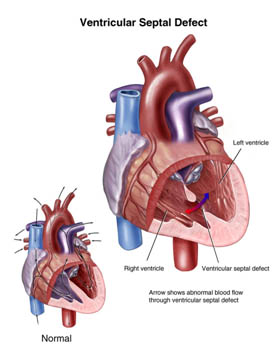[vc_row][vc_column][vc_column_text]
VSD SURGERY IN INDIA
What is a ventricular septal defect (VSD)?
 A ventricular septal defect (VSD) is a heart malformation present at birth. Any condition that is present at birth can also be termed a “congenital” condition. A VSD, therefore, is a type of congenital heart disease (CHD). The heart with a VSD has a hole in the wall (the septum) between its two lower chambers (the ventricles).
A ventricular septal defect (VSD) is a heart malformation present at birth. Any condition that is present at birth can also be termed a “congenital” condition. A VSD, therefore, is a type of congenital heart disease (CHD). The heart with a VSD has a hole in the wall (the septum) between its two lower chambers (the ventricles).
How common is a VSD?
The most frequent types of congenital malformations affect the heart. It is estimated that approximately eight in 1,000 newborns have CHD. A VSD is the most frequent of the various types of CHD (25%-30% of all CHD). Approximately one infant in 500 will be born with a VSD.
How is VSD diagnosed?
Ventricular septal defects frequently are diagnosed at birth or within a few days from birth because the doctor can hear the distinctive murmur. Older children or adults with an undetected VSD may experience shortness of breath with exercise or heart rhythm problems that send them to a doctor.
Diagnosis may include : –
- Chest x-ray
- Electrocardiogram to evaluate the heart’s electrical system
- Transthoracic Echocardiogram with Doppler imaging: Ultrasound images are obtained to show the size and function of the heart’s chambers, assess the condition of the heart valves and measure the velocity of blood flow across the VSD
- Coronary angiography in patients at risk of coronary artery disease or in patients over age 40 if a surgical repair is planned.
- MRI to detect other associated cardiac abnormalities
What is the success rate for VSD surgery?
Surgical closure of VSDs did not become a widespread procedure until the 1960s, so long-term data on outcomes and life expectancy is only now being collected and analyzed. Available data indicate that adults with closed VSDs and without other heart or lung complications can expect to live a normal lifespan. In the 40 years that the operation has been widely used, about 6 percent of patients have required a re-operation to close small leaks that developed around the patch. Are there any long-term problems or complications after surgery?
Within the first six months after surgical repair of a VSD, the person still has a risk of endocarditis while the heart heals. Your cardiologist can advise you on how to protect yourself from this life-threatening condition.
People with repaired VSDs may develop cardiac arrhythmias later in life, caused by scar tissue that develops ion the heart from the VSD surgery. Several effective treatments are available for arrhythmias; your cardiologist can advise whether your arrhythmia requires treatment. The risk of arrhythmias and sudden cardiac death is higher in patients who have undergone VSD repair late in life.
[/vc_column_text][/vc_column][/vc_row][vc_row][vc_column][vc_message style=”square” message_box_color=”mulled_wine”]
[/vc_message][/vc_column][/vc_row]
